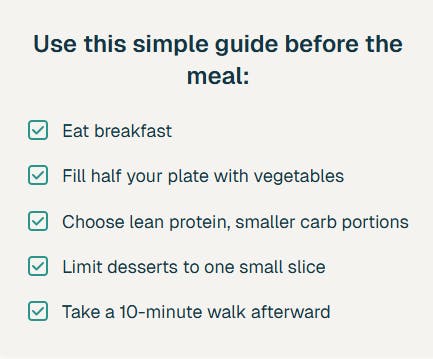The Holiday Buffet Meets Your Health
Thanksgiving is a time to gather, celebrate, and enjoy good food — but for those managing chronic conditions like high blood pressure, diabetes, gout, or digestive issues, it can also be a challenge. The good news? You don’t have to skip your favorite dishes to stay healthy.
With support from our CLS Health Registered Dietitian Nutritionist—and input from our heart, diabetes, digestive, and rheumatology specialists—you can enjoy your Thanksgiving meal with confidence. These tips will help you keep your plate balanced, your symptoms under control, and your holiday stress-free.
Know Your Triggers: What Holiday Meals Can Do to Your Body
Understanding how traditional Thanksgiving foods affect your body helps you plan ahead:
- Salt & sodium from gravy, stuffing, and brined turkey can spike blood pressure and stress the heart.
- Refined carbs and sweets can cause sharp blood glucose increases for those with diabetes.
- Purine-rich foods—like red meat, shellfish, and alcohol—may trigger gout flare-ups or joint pain.
- Heavy, fatty, or low-fiber meals can lead to indigestion or reflux, especially for those with GI or colorectal conditions.
Knowing these triggers allows you to make swaps before you even step up to the buffet table.
Building Your Plate: Smart Portion & Food Swap Strategies
A balanced Thanksgiving plate follows a simple rule:
Half vegetables, one-quarter lean protein, and one-quarter healthy carbs.
Try these swaps:
- Replace creamy casseroles with roasted vegetables drizzled in olive oil.
- Choose skinless turkey breast instead of dark meat for less fat (though both are similar in sodium).
- Use herbs, citrus, and spices instead of salt to enhance flavor without raising blood pressure.
Recommendations from Our Specialists:
- Cardiology: Focus on fiber-rich, lower-sodium foods to support heart and blood pressure health.
- Endocrinology: Control carbohydrate portions and avoid added sugars to steady glucose levels.
- Gastroenterology: Eat smaller bites slowly and skip heavy creams or fried items.
- Rheumatology: Choose anti-inflammatory foods like salmon, olive oil, and colorful vegetables to protect the joints.
Holiday Health Tips for Your Condition
High Blood Pressure / Cholesterol
- Skip or limit high-sodium dishes like stuffing, gravy, and brined turkey.
- Choose greens, beans, and whole grains to naturally reduce cholesterol.
- Go easy on creamy casseroles and buttered rolls — these have added saturated fat.
Diabetes & Blood Sugar Management
- Eat a balanced breakfast to prevent overeating later.
- Control carb-heavy sides (stuffing, potatoes, desserts) and monitor portions.
- Take a light walk after your meal to help regulate glucose levels.
Digestive & Colorectal Health
- Avoid fried or overly rich foods that may trigger reflux or bloating.
- Focus on fiber-rich vegetables and lean proteins.
- Stay hydrated and move after your meal to keep digestion on track.
Arthritis & Gout
- Limit alcohol and purine-rich meats (game, organ meats, shellfish).
- Include anti-inflammatory foods like olive oil, fish, and nuts.
- Skip fried or ultra-processed foods that can worsen inflammation.
After Your Meal: Activity & Mindset
- A simple 10–15-minute walk after eating can aid digestion, regulate blood sugar, and improve circulation.
- Remember: one indulgent meal won’t undo your progress — it’s what you do most of the time that matters.
- Practice mindful eating by chewing slowly, savoring flavors, and stopping when you’re about 80% full.
Planning Ahead: Pre-Meal & Leftover Strategies
- Eat a healthy snack earlier in the day (fruit, yogurt, or nuts) if dinner is late — this helps stabilize blood sugar.
- Stay hydrated throughout the day by choosing water with lemon, lime, or mint, or try sparkling water with a splash of fruit juice instead of sugary drinks or soda.
- If you’re hosting, try healthier versions of traditional dishes: low-sodium gravy, reduced-fat dressings, or roasted sides instead of fried ones.
- For leftovers, portion and freeze them. Balance the next day’s meals with lighter, high-fiber options.
Your Healthy Plate Checklist
Use this quick guide before your Thanksgiving meal to stay balanced and enjoy every bite.
Think of it as your Thanksgiving Plate Contract — a simple reminder that balance matters more than perfection.

When to Consult Your Specialist
If you have uncontrolled high blood pressure, cholesterol, diabetes, GI issues, or gout, talk to your doctor before the holiday.
At CLS Health, our specialists and dietitians partner to help patients make smart, sustainable food choices. From heart health and diabetes to digestive or joint concerns, we help you plan meals that are both safe and satisfying.
Ask about medication timing, alcohol use, portion control, and post-meal activity to enjoy the day worry-free.
Take the Next Step Toward a Healthier Holiday
You don’t have to navigate Thanksgiving alone—your CLS Health nutrition team is here to help you enjoy every celebration while protecting your health.
Whether you’re managing blood pressure, diabetes, gout, or digestive concerns, our specialists provide personalized nutrition and treatment guidance for lasting wellness.
We proudly serve patients from across the Houston area, offering same-week appointments and compassionate, whole-person care.
Schedule your appointment today and make this holiday season your healthiest yet.
FAQs
Yes — just keep your portion small, balance it with protein or fiber, and monitor your glucose after eating.
Smaller, balanced servings (especially high-sodium foods) are key. Focus on flavor from herbs, not salt.
Avoid high-purine items like red meat, shellfish, and organ meats. Limit alcohol, especially beer.
Drink sparingly—one glass of wine is fine for most, but always check with your cardiologist.
Eat smaller portions, chew slowly, and avoid heavy or spicy foods that can trigger reflux.





